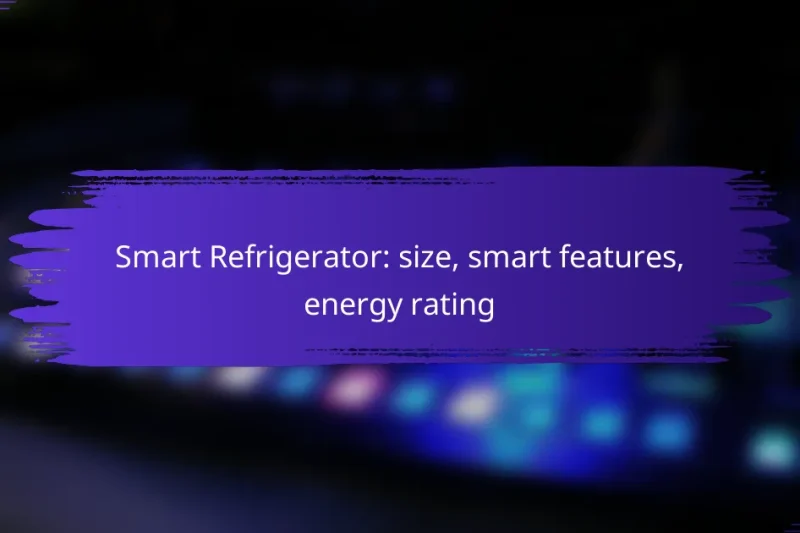Smart speakers have become essential devices in modern homes, offering impressive sound quality, advanced voice recognition, … Smart Speaker: sound quality, voice recognition, ecosystem compatibilityRead more
Smart home devices are revolutionizing the way we live by enhancing convenience, security, and energy efficiency in our homes. With a variety of options available, these technologies seamlessly integrate into daily life, automating routine tasks and optimizing resource usage. When choosing the right devices, it's essential to consider compatibility, ease of use, security features, and cost to ensure a harmonious and efficient smart home experience.
Smart Garden System: automated watering, plant monitoring, app control
Smart garden systems revolutionize gardening by automating watering and monitoring plant health, ensuring that plants receive … Smart Garden System: automated watering, plant monitoring, app controlRead more
Smart Speaker: privacy concerns, voice recognition errors, integration issues
Smart speakers have become increasingly popular, but they also raise important privacy concerns regarding data collection … Smart Speaker: privacy concerns, voice recognition errors, integration issuesRead more
Smart Smoke Detector: sensor type, connectivity, maintenance needs
Smart smoke detectors utilize advanced sensor technology to detect smoke and provide real-time alerts through connectivity … Smart Smoke Detector: sensor type, connectivity, maintenance needsRead more
Smart Pet Feeder: capacity, app features, design
Smart pet feeders are designed to streamline pet care by automating feeding schedules and portion control. … Smart Pet Feeder: capacity, app features, designRead more
Smart Thermostat: compatibility, user interface, installation ease
Smart thermostats offer a modern solution for temperature control in Canadian homes, with many models compatible … Smart Thermostat: compatibility, user interface, installation easeRead more
Smart Refrigerator: size, smart features, energy rating
Smart refrigerators are revolutionizing kitchen convenience by combining advanced technology with energy efficiency and spacious storage. … Smart Refrigerator: size, smart features, energy ratingRead more
Smart Blinds: material, control options, installation requirements
Smart blinds are an innovative solution for modern homes, providing a blend of style, energy efficiency, … Smart Blinds: material, control options, installation requirementsRead more
Smart Door Lock: keyless entry, remote access, security alerts
Smart door locks offer a seamless blend of convenience and security, allowing for keyless entry and … Smart Door Lock: keyless entry, remote access, security alertsRead more
Smart Light Bulbs: connectivity issues, compatibility, color accuracy
Smart light bulbs offer innovative lighting solutions, but users often face challenges related to connectivity, compatibility, … Smart Light Bulbs: connectivity issues, compatibility, color accuracyRead more
What are the best smart home devices for Canadians?
The best smart home devices for Canadians include options that enhance convenience, security, and energy efficiency. Popular choices are designed to integrate seamlessly into daily life while offering reliable performance in the Canadian climate.
Google Nest Hub
The Google Nest Hub is a versatile smart display that serves as a central control point for your smart home devices. It features a 7-inch touchscreen that allows you to manage everything from lights to thermostats using voice commands or touch.
Consider its compatibility with a wide range of smart home products, making it an excellent choice for those looking to create a cohesive ecosystem. The Nest Hub also offers Google Assistant, which can help with tasks like setting reminders or playing music.
Amazon Echo Show
The Amazon Echo Show combines a smart speaker with a display, providing both audio and visual experiences. With various screen sizes available, it can fit into different spaces in your home, from kitchens to living rooms.
This device allows you to control compatible smart home devices, make video calls, and access streaming services. Its integration with Alexa makes it easy to manage tasks through voice commands, enhancing your smart home experience.
Philips Hue Smart Bulbs
Philips Hue Smart Bulbs offer customizable lighting solutions that can be controlled remotely or set on schedules. These LED bulbs are available in various colors and brightness levels, allowing you to create the perfect ambiance for any occasion.
Installation is straightforward, as they fit standard light sockets, and they connect to your Wi-Fi network. Consider using the Philips Hue app to manage your lighting preferences and explore automation options for energy savings.
Ecobee Smart Thermostat
The Ecobee Smart Thermostat is designed to optimize your home's heating and cooling systems. It learns your preferences over time and adjusts the temperature accordingly, which can lead to significant energy savings.
With features like remote sensors, you can ensure comfort in every room. The thermostat is compatible with most HVAC systems and can be controlled via a smartphone app, making it easy to manage your home's climate from anywhere.
Ring Video Doorbell
The Ring Video Doorbell enhances home security by allowing you to see and communicate with visitors at your door through your smartphone. It features HD video and two-way audio, enabling real-time interaction.
Installation is simple, and it can be powered by battery or hardwired. Consider subscribing to Ring's cloud service for additional features, such as video storage and advanced motion detection alerts, which can be particularly useful in urban areas.
How do smart home devices improve daily life?
Smart home devices enhance daily life by providing convenience, increasing energy efficiency, and improving security. These technologies automate routine tasks, optimize resource usage, and offer advanced safety features, making homes more comfortable and secure.
Convenience and automation
Smart home devices streamline everyday tasks through automation, allowing users to control appliances, lighting, and climate with ease. For instance, smart thermostats can adjust temperatures based on your schedule, while smart speakers enable voice commands for various functions.
Consider integrating devices like smart plugs or light bulbs that can be programmed or controlled remotely. This not only saves time but also simplifies managing multiple devices from a single app or platform.
Energy efficiency
Energy-efficient smart home devices help reduce utility bills by optimizing energy consumption. Smart thermostats, for example, can learn your habits and adjust heating or cooling accordingly, potentially saving users around 10-20% on energy costs.
Additionally, smart lighting systems can automatically turn off when rooms are unoccupied. Investing in energy-efficient devices can lead to significant savings over time, making them a practical choice for environmentally conscious homeowners.
Enhanced security
Smart home devices significantly bolster home security through features like remote monitoring, alerts, and automated locks. Security cameras and smart doorbells allow homeowners to monitor their property in real-time from their smartphones, providing peace of mind.
Consider using smart locks that can be controlled remotely, enabling you to grant access to guests without being home. Combining these devices with a comprehensive security system can create a robust defense against potential threats.
What are the key features to consider when choosing smart home devices?
When selecting smart home devices, it's crucial to evaluate compatibility, ease of use, security features, and cost. These factors will help ensure that the devices work well together, are user-friendly, protect your data, and fit within your budget.
Compatibility with ecosystems
Compatibility with existing ecosystems is essential for seamless integration. Many smart home devices operate within specific ecosystems like Amazon Alexa, Google Assistant, or Apple HomeKit. Before purchasing, verify that the device you choose can connect with your preferred ecosystem to avoid compatibility issues.
Check for compatibility with protocols such as Zigbee, Z-Wave, or Wi-Fi, as these can affect how devices communicate. A device that works with multiple ecosystems offers greater flexibility and future-proofing.
Ease of use
Ease of use is a significant factor when selecting smart home devices. Look for devices that offer intuitive interfaces, straightforward setup processes, and user-friendly apps. A device that is easy to operate will enhance your overall experience.
Consider how often you will interact with the device. For example, smart thermostats should allow quick adjustments, while smart lights should enable simple scheduling and control through voice commands or mobile apps.
Security features
Security features are critical when choosing smart home devices, as they can be vulnerable to hacking. Look for devices that offer encryption, regular firmware updates, and strong password protection. These features help safeguard your personal information and ensure the integrity of your home network.
Additionally, consider devices that allow for two-factor authentication. This adds an extra layer of security, making it more difficult for unauthorized users to gain access.
Cost and value
Cost and value are vital considerations when selecting smart home devices. Prices can vary widely, so it's essential to determine your budget and what features are most important to you. While some devices may have a higher upfront cost, they often provide better performance and longevity.
Evaluate the long-term savings that smart devices can offer, such as reduced energy bills from smart thermostats or improved security that can lower insurance premiums. Compare different brands and models to find the best balance between cost and functionality.
What are the top brands in smart home technology?
The leading brands in smart home technology include Amazon, Google, Apple, and Samsung SmartThings. Each brand offers unique features and ecosystems that cater to different user preferences and needs.
Amazon
Amazon's smart home devices are primarily centered around the Alexa ecosystem, which includes Echo speakers and smart displays. These devices allow users to control compatible smart home products through voice commands, making home automation intuitive and accessible.
Consider the wide range of compatible devices available, from smart lights to security cameras. Amazon's offerings often provide competitive pricing, especially during sales events, making them an attractive option for budget-conscious consumers.
Google's smart home technology is anchored by Google Assistant, which powers devices like Google Nest speakers and displays. This integration allows for seamless control of various smart home devices using voice commands or the Google Home app.
Google's ecosystem is known for its strong compatibility with third-party devices, offering users flexibility in choosing products. Additionally, Google frequently updates its software, enhancing functionality and user experience over time.
Apple
Apple's approach to smart home technology is encapsulated in its HomeKit platform, which emphasizes security and privacy. Devices that support HomeKit can be controlled via the Apple Home app or Siri, providing a cohesive experience for Apple users.
While Apple products tend to be on the pricier side, they are known for their high-quality design and reliability. Users should consider the compatibility of devices with HomeKit before purchasing to ensure a smooth integration.
Samsung SmartThings
Samsung SmartThings offers a versatile platform for managing a wide array of smart home devices, regardless of brand. The SmartThings hub serves as a central controller, allowing users to automate and monitor their home environment easily.
One of the key advantages of SmartThings is its compatibility with a broad range of devices, including those from other manufacturers. Users should explore the SmartThings app for setting up automations and routines that suit their lifestyle, ensuring a tailored smart home experience.
How do smart home devices integrate with each other?
Smart home devices integrate through various communication protocols and platforms, allowing them to work together seamlessly. This integration enhances user experience by enabling automation and remote control across different devices, creating a cohesive smart home ecosystem.
Using smart hubs
Smart hubs act as central control units that connect multiple smart home devices, allowing them to communicate with one another. These hubs can support various protocols like Zigbee, Z-Wave, and Wi-Fi, enabling compatibility among devices from different manufacturers.
When choosing a smart hub, consider the types of devices you plan to use and their communication standards. Popular options include the Samsung SmartThings Hub and Amazon Echo Plus, which offer extensive compatibility and user-friendly interfaces.
To maximize the benefits of a smart hub, ensure that all devices are compatible with the hub's protocol. Regularly update the hub's firmware to maintain security and functionality, and avoid overcrowding the hub with too many devices, which can lead to performance issues.














